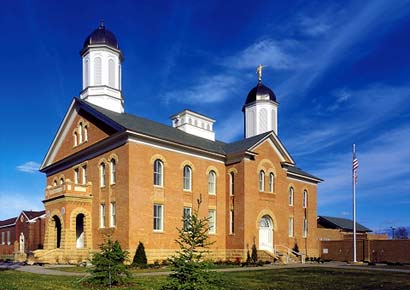Vernal
Uintah County, Utah

The Vernal Tabernacle, now the Vernal Temple
Vernal
Uintah County, Utah

The Vernal Tabernacle, now the Vernal Temple
Uintah County has a population of 24,500. Vernal, the largest city, is also the county seat. Unlike most Utah cities and towns, Vernal was not settled by Mormon pioneers. Brigham Young sent a scouting party to Uinta Basin in 1861 and received word back the area was good for nothing but Indian hunting grounds.
That same year, President Abraham Lincoln set the area aside as the Uintah Indian Reservation, appointing Captain Pardon Dodds Indian agent. When Dodds retired, he moved Ashley Valley along with agency workers, Morris Evans and John Blankenship to raise livestock. Arriving on February, 14 1873, they settled on Ashley Creek and Dodds built the first cabin in the valley, about 4 miles northwest of present-day Vernal.
The area where Vernal is now located was called the Bench, and was described as a large barren cactus flat when the David Johnston family moved there on June 6, 1878. The area was reportedly filled with cactus, lizards, horned toads, scorpions, mice and snakes until 1879.
After Colorado's Meeker Massacre in September of that same year, a fort was built on the Bench where many new settlers moved their cabins for protection. The town that grew out of the fort became known as Ashley Center, but when residents applied for a post office, the U.S. Postal Department assigned the name Vernal because Ashley was already taken.
The Mormon Church helped establish Vernal as a city in 1884, but the
town wasn't incorporated until 1897. Because of the distance to a major
railhead, settlers were self-sufficient, with cattle and sheep raising,
milling, honey production, and farming grains and alfalfa being the primary
industries. Livestock and agriculture, together with the tourist industry,
remain important to this day.